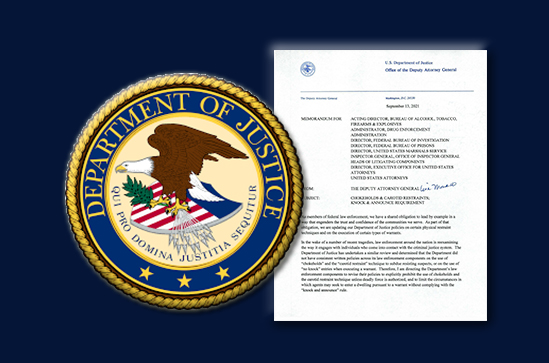
The Department of Justice today announced written department-wide policies explicitly prohibiting the use of “chokeholds” and “carotid restraints” unless deadly force is authorized, and limiting the circumstances in which the department’s federal law enforcement components are authorized to use unannounced entries. The announcement follows a review with the department’s law enforcement agencies led by Deputy Attorney General Lisa O. Monaco.
“Building trust and confidence between law enforcement and the public we serve is central to our mission at the Justice Department,” said Attorney General Merrick B. Garland. “The limitations implemented today on the use of ‘chokeholds,’ ‘carotid restraints’ and ‘no-knock’ warrants, combined with our recent expansion of body-worn cameras to DOJ’s federal agents, are among the important steps the department is taking to improve law enforcement safety and accountability.”
“As members of federal law enforcement, we have a shared obligation to lead by example in a way that engenders the trust and confidence of the communities we serve,” said Deputy Attorney General Monaco. “It is essential that law enforcement across the Department of Justice adhere to a single set of standards when it comes to ‘chokeholds,’ ‘carotid restraints’ and ‘no-knock’ entries. This new policy does just that and limits the circumstances in which these techniques can be used.”
Under the new policy, the department’s law enforcement components will be prohibited from using “chokeholds” and “carotid restraints” unless deadly force is authorized, that is “when the officer has a reasonable belief that the subject of such force poses an imminent danger of death or serious physical injury to the officer or to another person.”
Federal agents are generally required to “knock and announce” their identity, authority and purpose, and demand to enter before entry is made to execute a warrant in a private dwelling. However, there are some circumstances where unannounced entries are authorized. The new policy generally limits the use of “no knock” entries in connection with the execution of a warrant to situations where an agent has reasonable grounds to believe that knocking and announcing the agent’s presence would create an imminent threat of physical violence to the agent and/or another person. This new policy is narrower than what is permitted by law. In setting the policy this way, the department is limiting the use of higher-risk “no knock” entries to only those instances where physical safety is at stake. If an agent suspects a threat to physical safety and seeks a “no knock” warrant, the agent must first get supervisory approval from both a federal prosecutor as well as the agent’s law enforcement component.
The policy does recognize, however, that there may be rare circumstances when there is justification – other than physical safety – to execute a “no knock” entry. If an exception is sought when there is no imminent threat of physical safety, the agent must first get approval from the head of the law enforcement component and the U.S. Attorney or relevant Assistant Attorney General before seeking judicial authorization for a “no knock” warrant.
For more information, see the Deputy Attorney General’s guidance to the Justice Department’s law enforcement components:
2021.09.13Chokeholds & Carotid Restraints; Knock & Announce Requirement us dept of justic
Today’s announcement expands on the department’s efforts to examine the way Justice Department law enforcement components engage with individuals who come into contact with the criminal justice system. See the Deputy Attorney General’s June 7, 2021, memo regarding Body Worn Cameras for the Justice Department’s federal law enforcement agents as well as the Sept. 1, 2021, announcement of the first Justice Department agents to implement BWCs:
Read Justice Department Announces First Federal Agents to Use Body-Worn Cameras
and
june2021 Body-Worn Camera Policy us dept of just
US Dept of Justice


Bulloch Public Safety
12/05/2025 Booking Report for Bulloch County

Chattooga Local News
Carr Convicts 16 in Barrow County, Shuts Down Prison Gang Operation

Bulloch Public Safety
12/04/2025 Booking Report for Bulloch County

Bulloch Public Safety
11/10/2025 Booking Report for Bulloch County

Bulloch Public Safety
11/24/2025 Booking Report for Bulloch County

Bulloch Public Safety
11/06/2025 Booking Report for Bulloch County

Bulloch Public Safety
12/01/2025 Booking Report for Bulloch County

Bulloch Public Safety
11/12/2025 Booking Report for Bulloch County






